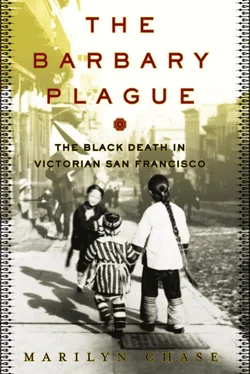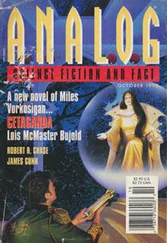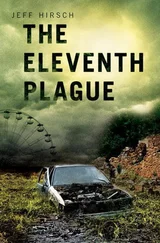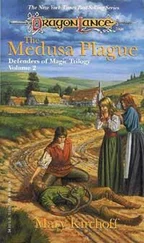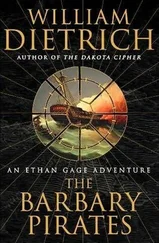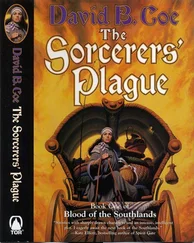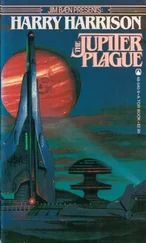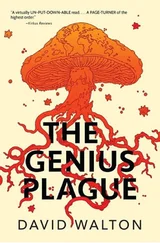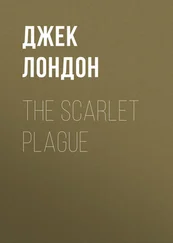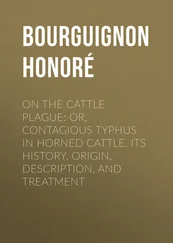Bad luck was believed to visit any house where a tenant died, so Wong’s inert body was hauled from the Globe’s basement and carried to a nearby coffin shop. The sau pan po was literally a shop for selling “long-life boards.” 7But there, Wong’s life ended. His agonal gasps slowed, their intervals lengthening. His chest contracted. He exhaled his last breath.
When police surgeon F. P. Wilson arrived at the Wing Sang coffin shop, he unwrapped the corpse. His fingers began palpating the contours of Wong’s livid form, where rigor mortis was beginning to set in. His fingers found the swollen lymph glands. Plainly visible on the dead man’s thigh was a small sore, festering where Wong had scratched at some irritation. Perhaps it was an insect bite. The police surgeon sent for city health officer A. P. O’Brien. Together they telephoned a young city bacteriologist named Wilfred Kellogg.
As midnight approached, Wilson, O’Brien, and Kellogg performed a postmortem examination, mining the body for clues. They pierced the lumps and withdrew fluid from the knot of inflamed glands. They extracted blood and straw-colored lymph fluid, with bits of pink pulpy tissue from the body, saving it for analysis. Under the microscope lens, a swarm of bacteria swam into focus—clusters of short, rod-shaped germs with rounded tips that, when stained, turned pink and looked like closed safety pins.
It looked suspiciously like plague.
Plague reports had been trickling out of Hong Kong and Hawaii for some time, putting the city’s health officers on alert for any sudden death from fever. But the city’s bacteriology laboratory needed to confirm these suspicions. A final diagnosis required a senior expert, someone with a more sophisticated lab outfit and time to corroborate the findings. They knew where to find such an expert, at the quarantine station on Angel Island, but city officials didn’t wait for a definitive diagnosis.
Police officers descended on Chinatown in the darkness, stringing ropes around its dozen square blocks. Whites were ushered out of Chinatown, and the Chinese were sealed inside. Panic exploded among the confined. Some raced the length of the barriers, pacing the perimeter, looking for a way out. But police patrolled the barricades, clubs at the ready. Only police and health officers could cross the cordon sanitaire.
Making his evening rounds, a reporter for Chung Sai Yat Po , the Chinatown daily newspaper, saw the siege unfold. He raced back to the newspaper headquarters to prepare his report:
The Caucasian doctor examining the body was shocked to find that the person died of an epidemic illness. That is why they put the quarantine on Chinatown to prevent spreading of the disease. Alas, the epidemic was caused by the imbalance of Qi, the energy of the four seasons. It cannot be spread from person to person…. By Friday, it is hoped that we will know that this was not the plague. Otherwise what happened in Honolulu might happen to us. 8
“Honolulu”—fear clutched the throats of all who whispered the word. Chinatown’s residents knew all about the incineration of Honolulu just a couple of months earlier. As the crowds milled about in increasing alarm, they watched as Wong Chut King’s clothes and bedding were pitched into the street and set alight. Flames crackled and smoke curled up, showering ashes like gray snow. Health officers lugged in sulfur pots and began fumigating the coffin shop. The air smelled of rotten eggs. Wong’s body was wrapped in a linen shroud that had been soaked in an antiseptic solution of bichloride of mercury and sealed in a lead coffin lined with powdery chloride of lime. The coffin was loaded onto a horse cart and driven over cobblestones west of downtown to the Odd Fellows Cemetery. There, the body was given to the flames.
Autopsy and cremation was the fate prescribed by health departments for any victim of an epidemic disease. But cutting and burning of the body violated the Confucian principle of filial piety. Autopsy was considered an affront to the parents of the deceased, who gave him life; and cremation was the final desecration. Such practices left a disembodied spirit in the void. “The ashes will be scattered in the air,” wrote the reporter for the Chinese daily, “and let go to the home of nothingness, the cave of emptiness.” 9
Chinatown had its own view of what ailed Wong Chut King, and it was certainly not the plague. Elders confided that the lumberman, like many bachelor workers who visited the green mansions—suffered from “notorious gonorrhea,” also known as “poisonous mango-shaped lump.” 10
In a community of lonely laborers living a continent away from their wives, such ills were as common an occupational hazard as callused hands. Although venereal disease was an unsavory topic, it would not bring down the fiery retribution on the neighborhood that was promised by a diagnosis of plague.
Speculation about the torching of the Globe Hotel reached the ears of its tenants, who fled their bunks and vanished like smoke. But the Globe wasn’t burned to the ground. Instead, the city continued its chemical assault, fumigating and spraying acrid chemicals in hopes of purging the disease. The sanitation had its drawbacks. The smoking pots of sulfur smudged paint, spoiled hangings, and ruined upholstery. In neighboring stores, it would yellow pale silks and silt carvings with gritty smoke residue. Thick, rank clouds blinded residents with tears and sent them choking and sputtering into the streets for air. If the disease didn’t kill them, they guessed the cure surely would.
The confined stared longingly at the world outside the cordon. Outside were jobs, money, food. A brave and foolhardy few tried to vault over or slip under the barricades. The crack of a billy club brought the escapees back into quarantine.
From his official residence in Chinatown, the Chinese consul, Ho Yow, watched the street scene unfold below with a leaden heart.
At home in two worlds, Ho spoke perfect English but posed for portraits in the traditional silk robes and dark silk skullcap of a senior Asian diplomat. Although he was his country’s designated representative of Chinese culture, he enjoyed Western sports like harness racing, and he raced his champion mare, Solo, all over Northern California. Solo trotted to victory behind a driver clad in red-and-blue racing silks, embroidered with a magnificent dragon with shimmering scales and flashing eyes.
Ho knew well the danger of Black Death. In his father’s household in China, two servants had died of plague. 11But, he argued, blockading the whole district was discrimination. Anyone could see the quarantine rope markedly zigzagged to exclude white stores on the boundaries of Chinatown.
More than the plague itself, Consul Ho feared that the quarantine would provoke a relapse of exclusion-law fever. He begged the city to be fair to his people. Immigrants born in China were barred from becoming naturalized U.S. citizens. They were legally subjects of the emperor of China. Even Chinese people born in America hadn’t been deemed citizens until two years earlier, when the 1898 U.S. Supreme Court formally recognized their status in the case of Wong Kim Ark. Still, in the eyes of the white majority, their Asian features and golden hue stamped them indelibly as aliens.
Ho sought out the Chinese Six Companies. More than just a Chinese Chamber of Commerce, the group functioned as de facto diplomats, working with the consul to keep peace between the tongs and untangle immigration snarls. Now, facing quarantine, Ho and the Chinese Six Companies had another mission: protecting the civil rights of their people. So they hired lawyers and vowed to defend their small stake in America.
On Gold Mountain in the Year of the Rat, the bad times were about to get worse.
Читать дальше
